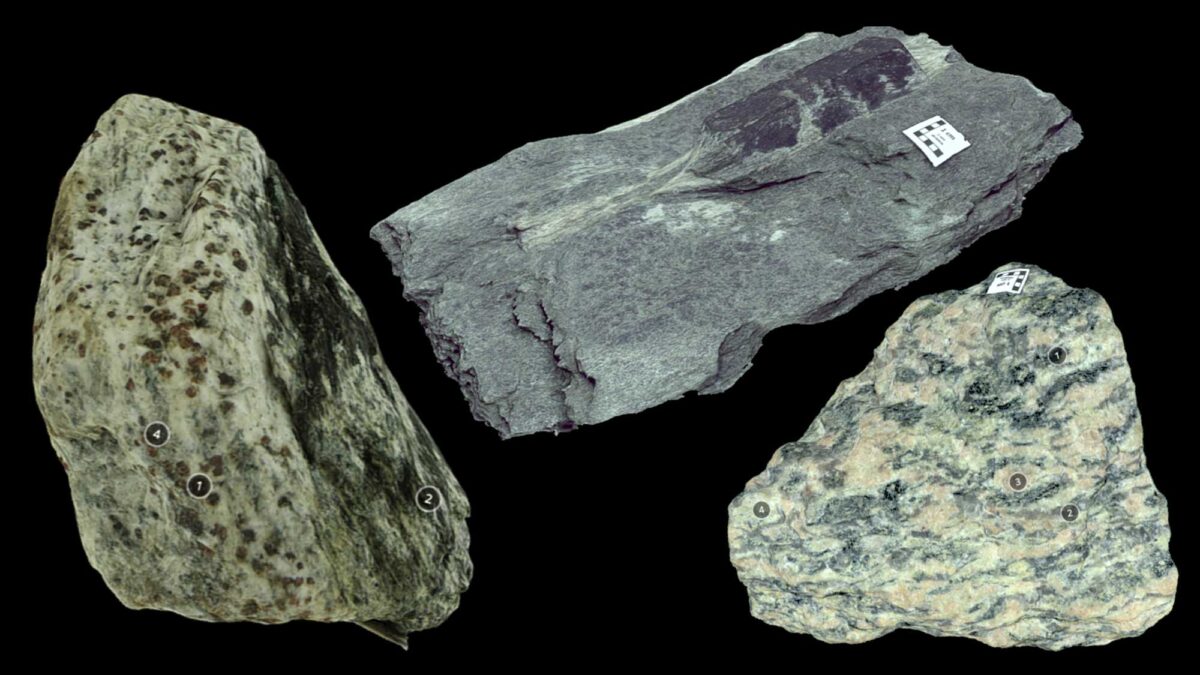Virtual Rock Collection
Igneous Rocks
Sedimentary Rocks
Metamorphic Rocks
Image above: Examples of different types of foliated metamorphic rocks. Sources of individual rock images are derived from 3D models on Sketchfab with Creative Commons licensing; see same models below for creator credits and licensing details.
Overview
The texture of a rock has to do with the arrangement, sizes, and shapes of its crystals. Metamorphism always alters the texture of rock. One type of altered texture is foliation, wherein minerals become grouped in parallel arrangements. This happens because platy minerals such as micas and chlorites become aligned at an angle relative to a direction of force.
The six types of foliated metamorphic rocks highlighted below (slate, phyllite, schist, gneiss, amphibolite, and migmatite) are arranged by the increasing amount of temperature and pressure required for their formation. They are classified based on the nature of their foliation and their crystal size.
Slate
Slate is formed from metamorphosed shale or volcanic ash; it is often dark in color. Grains of slate are microscopic and are composed mostly of clays, micas, and chlorite. This type of rock often breaks at an angle relative to its original bedding. Slate is a low-grade metamorphic rock.
Original caption: "Slate is a low-grade pelitic metamorphic rock. It is distinguished from higher grade grade phyllite by having a lower proportion of newly crystallised minerals, and accordingly, a lower sheen on the cleavage surface. Conversely, slate also contains a high proportion of the original sedimentary components such as silt and clay. Unlike shale, the layering present here is not sedimentary in origin, but tectonic. Growth of new phyllosilicates such as muscovite and chlorite creating a planar structure in the rock. Note that these metamorphic minerals are still too small to be seen with the naked eye." Model by Earth Sciences, University of Newcastle (Sketchfab).
Phyllite
Like shale, phyllite is also ultimately derived from shale; it represents continued metamorphism of slate. The grains of phyllite are small, but not microscopic. Micas are dominant, giving samples of phyllite a shiny appearance; quartz and chlorite are also common. Phyllite is a low- to medium-grade metamorphic rock.
Original caption: "Phyllite is a low-grade pelitic metamorphic rock. It is distinguished from lower grade slate by having a higher proportion of newly crystallised minerals, and accordingly, a higher sheen. It is is distinguished from higher grade schist in that the metamorphic minerals are still too small to be seen with the naked eye. Note that the layering present here is not sedimentary in origin, but tectonic. Growth of new phyllosilicates such as muscovite and chlorite creating a planar structure in the rock." Model by Earth Sciences, University of Newcastle (Sketchfab).
Schist
Schist is derived from metamorphosed shale, carbonates, or mafic igneous rocks. It exhibits fine- to medium-sized grains. Micas, chlorite, quartz, talc, garnet, hornblende, and graphite are all common in schist. The presence of micas give schist a sparkly appearance, similar to fish scales. Schist is a low- to high-grade metamorphic rock.
Original caption: "Biotite-garnet schist, Zillertal, Austrian Alps." Model by Sara Carena (Sketchfab; Creative Commons Attribution 4.0 International license).
Original caption: "This tourmaline-muscovite schist bears a single large hexagonal tourmaline crystal in an otherwise fine grained matrix. Muscovite and quartz dominate the matrix and other minerals present include staurolite (too small to see in this model)." Model by Earth Sciences, University of Newcastle (Sketchfab; Creative Commons Attribution-NonCommercial 4.0 International license).
Gneiss
Metamorphism of shale, sandstone, or felsic igneous rocks may result in the formation of gneiss (pronounced "nice"). Samples of gneiss are characterized by very distinct foliated bands of light and dark color, with large grain sizes. Abundant minerals include quartz, feldspars, micas, and hornblende. Gneiss is a high-grade metamorphic rock.
Original caption: "This quartzo-feldspathic gneiss is an S-tectonite (it has a foliation, but no lineation). Quartz, plagioclase and alkali feldspar (probably orthoclase) dominate the rock and are accompanied by minor biotite. Possible protoliths include granite, felsic volcanics, or even a lithic sandstone." Model by Earth Sciences, University of Newcastle (Sketchfab; Creative Commons Attribution-NonCommercial 4.0 International license).
Sample of gneiss. Model by Nate Siddle and the University of Queensland, School of Earth and Environmental Sciences (Sketchfab).
Amphibolite
Amphibolite is derived from mafic igneous rock. It usually has a dark color and weak foliation. Abundant minerals include hornblende and plagioclase. Amphibolite is a medium- to high-grade metamorphic rock.
Original caption: "This amphibolite is dominated by the minerals hornblende and plagioclase, with minor quartz also present. Due to the prismatic morphology of these minerals, the rock is lineated rather than foliated. The lineation is orientated parallel to the top edge in the initial view - the lineation is more easily observed on the weathered rear surface of the specimen. Close inspection of the left-hand end of the specimen (in initial viewpoint) shows what looks like a massive structure, because you are looking into the lineation." Model by Earth Sciences, University of Newcastle (Sketchfab).
Migmatite
Migmatite results from metamorphism of felsic igneous rock (e.g., granite) that then partially remelts. As a result, they are a combination of metamorphic and igneous rocks (e.g., streaks of granite mixed with gneiss). Folded banding is often evident. Abundant minerals include quartz, feldspar, micas, and hornblend. Migmatite is a high-grade metamorphic rock.
A sample of migmatite that exhibits ptygmatic folding. Model by Nate Siddle and the University of Queensland School of Earth and Environmental Sciences (Sketchfab).



